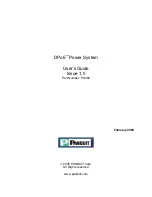
16/24-Port PoE Switch
@>---------------�
Device Management
6.1 Ring Network
6.1.1 STP Definition
The basic idea of STP protocol is very simple. We all know that the trees growing in the nature
won't generate loop circuit, so it won't generate loop circuit if network grows like trees in the
nature. Therefore, it defines Root Bridge, Root Port, Designated Port, Path Cost and other
concepts in the STP protocol, which is to realize the purpose of clipping redundant loop
circuit via structuring a tree, and meanwhile it can realize link backup and path optimization.
The algorithm of structuring the tree is called Spanning Tree Algorithm.
The protocol packet adopted by STP is BPDU (Bridge Protocol Data Unit), which is called
config info as well. BPDU contains enough information to ensure the calculation process of
completing spanning tree. STP can confirm network topological structure via transmitting
BPDU among devices.
BPDU format and field description can realize the functions of spanning tree, it is to realize
information interaction via transmitting BPDU packet among switches. All the switches which
support STP protocol will receive and deal with the received packet. The packet carries all
the useful information in the data area which can be used for spanning tree calculation. The
BPDU frame format and field description of standard spanning tree is shown in Figure 6-1.
?
-
Protocol
Identifier
Version
Bridge ID
Port ID
8
2
Message
Flag
Type
cssagc
Age
Max Age
2
2
Figure 6-1
• Protocol identifier: The identification of protocol.
• Version: The protocol version.
• Message type: BPDU type.
e Flag: Flag bit.
8
4
Root ID
Roor Parh
Cost
Hello Time
Forward
Delay
2
2
• ROOT ID: Root Bridge ID, which is made up of 2 bytes priority and 6 bytes MAC address.
• Root path cost: The cost of root path.
• Bridge ID: it means the ID of bridge which sends BPDU, which is made up of 2 bytes
priority and 6 bytes MAC address.
• Port ID: It is to identify the port which sends BPDU.
• Message age: Life time of BPDU.
• Max age: Aging time of current BPDU, which is the longest time for port to save BPDU.
• Hello time: The period cycle of Bridge Root sending BPDU.
• Forward delay: It means the time of maintaining snoop and study status before sending
data package after topology is changed.
6.1.2 Basic Concepts of STP
Bridge Identifier: it is the comprehensive numerical value of bridge priority and its MAC
address, and the bridge priority is a parameter which can be set. The lower the Bridge ID,
the higher the bridge priority becomes, which makes it increase the possibility of becoming
Root Bridge.
Root Bridge: It is the switch with minimum bridge ID. Please select the best switch among
the loop circuit and set it as the Root Bridge switch, which is to provide best network
performance and reliability.
Designated Bridge: in each network segment, the bridge with lowest path cost to Root
Bridge will become designated bridge, via which the data package will be forwarded to
the network segment. The switch with the lowest Bridge ID will be selected as Designated
Bridge when all the switches have the same Root Path Cost.
Root Path Cost: it is the total of all path costs on the path between two network bridges.
The Root Path Cost of Root Bridge is zero.
Bridge Priority: it is a parameter which can be set by users, the range of numerical is from
Oto 61440. The smaller the value is set, the higher the priority becomes. The higher the
bridge priority is, the more likely it becomes Root Bridge.
Root Port: the nearest port to root bridge on the non-root bridge switch, responsible for
communication with Root Bridge, the path cost from this port to root bridge is the lowest.
The port with highest port priority will become root port when several ports have the same
path cost to Root Bridge.
Designated Port: it is the port on the designated bridge which implements data forward to
the switch.
Port priority: range of numerical value is from Oto 240, and it has to be the integral multiple
of 16. The lower the port priority, the higher the priority means, and it is more likely to
become root port.
Path Cost: STP protocol is used to select reference value of link. STP protocol can clip the
network to a tree-shaped network structure without loop circuit via calculating path cost
and blocking redundant links.
The networking diagram of spanning tree basic concept is shown in Figure 6-2. Switch A,
B and C are connected sequentially, switch A is selected as Root Bridge after calculation
by STP, the circuit between port 2 and port 6 is blocked.
Bridge: Switch A is the root bridge of the whole network; Switch B is the designated bridge
of Switch C.
Port: port 3 and port 5 are the root ports of Switch B and Switch C respectively; port 1 and
port 4 are the designated ports of Switch A and Switch B respectively; port 6 is the blocked
port of Switch C.












































